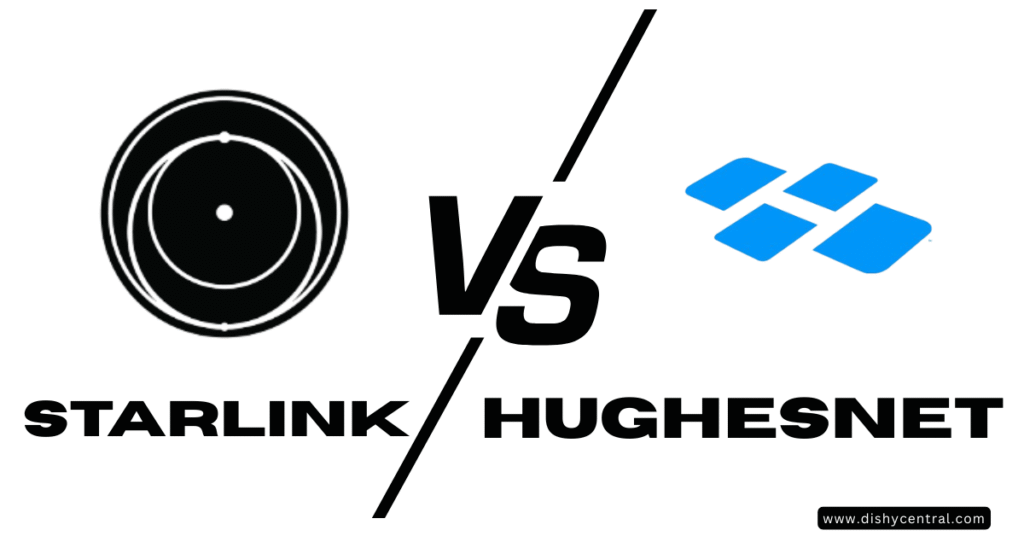Living in a remote area doesn’t mean you have to settle for slow internet anymore. The satellite internet landscape has transformed dramatically, with HughesNet vs Starlink becoming the most important comparison for rural internet seekers in 2025. While both satellite internet providers promise to bridge the digital divide, they deliver vastly different experiences that could make or break your online activities.
If you’re tired of buffering videos and dropped video calls, you’re not alone. Choosing the right satellite internet service can mean the difference between frustrating connectivity and seamless streaming. This comprehensive guide cuts through the marketing fluff to give you the real story about these two satellite internet options.
Key Takeaways
- Starlink offers superior performance with speeds up to 220 Mbps and low latency (25-60ms)
- HughesNet provides budget-friendly entry with lower upfront costs but significant data limitations
- Starlink is better for most users who need reliable internet for work, streaming, or gaming
- HughesNet works for basic needs like email and light web browsing on a tight budget
- Understanding Satellite Internet Technology in 2025
- HughesNet: The Established Satellite Internet Provider
- Starlink: The Revolutionary Satellite Internet Service
- HughesNet vs Starlink – Head-to-Head Comparison: Key Factors That Matter
- Real-World Usage Scenarios
- Making Your Decision: Which Satellite Internet Provider Wins?
- The Bottom Line: A Generational Leap Forward
- Frequently Asked Questions
Understanding Satellite Internet Technology in 2025
Before diving into the Starlink vs Hughesnet comparison, it’s crucial to understand how satellite internet works and why it matters for your daily experience.
Traditional satellite internet relies on geo satellites positioned 22,000 miles above Earth. This massive distance creates inherent delays that make real-time activities challenging. However, newer satellite constellation technology is revolutionizing how we think about satellite connection quality.
The satellite internet service landscape has evolved beyond simple internet access. Today’s satellite internet providers offer solutions that can rival traditional fiber internet in many aspects, though the technology behind each service varies dramatically.
| Related: How Does Starlink Work: A Complete Technical Breakdown
HughesNet: The Established Satellite Internet Provider
Product Overview
HughesNet has been a cornerstone satellite internet provider for over two decades, serving rural America when few other options existed. As a satellite internet service that relies on geo satellite technology, HughesNet delivers internet connection through large satellites positioned in geostationary orbit.
The company operates as a traditional internet service provider, offering structured internet plans with defined data allowances. HughesNet plans typically include “priority data” allocations, after which speeds are throttled significantly. Their latest initiative, HughesNet Fusion, attempts to address some latency issues by combining satellite and wireless internet technologies.
HughesNet also offers various installation options and has expanded its service coverage to most areas where traditional internet options aren’t available. The satellite provider has maintained its position by focusing on affordability and widespread availability.

Benefits + Features
Wide Coverage Area: HughesNet is available across the continental United States, making it accessible to most rural locations where traditional internet services aren’t feasible.
Professional Installation: Unlike some competitors, HughesNet includes professional installation with their satellite dish setup, ensuring optimal positioning and configuration.
Built-in Wi-Fi: All HughesNet plans include a built-in Wi-Fi modem, eliminating the need for additional equipment purchases.
Bonus Zone Hours: HughesNet offers additional data during off-peak hours (2 AM – 8 AM), providing extra internet access when network usage is lower.
Established Support Network: With decades in the business, HughesNet has developed an extensive customer service infrastructure and local dealer networks.
HughesNet Fusion Option: Their hybrid service combines satellite and wireless internet to potentially reduce latency issues in select areas.
HughesNet Pros and Cons
| Pros | Cons |
|---|---|
| ✓ Lower monthly costs ($74.99-$94.99) | ✗ High latency (600-800ms) makes gaming/video calls difficult |
| ✓ Professional installation included | ✗ Data throttling after priority data is used |
| ✓ Wide availability across rural areas | ✗ 24-month contract requirement |
| ✓ Equipment lease options available | ✗ Slower speeds compared to modern alternatives |
| ✓ Established customer support | ✗ Weather can significantly impact connection |
| ✓ Built-in Wi-Fi equipment | ✗ Upload speeds remain very limited |
Personal Opinion / Use Case
HughesNet works best for users with genuinely basic internet needs and strict budget constraints. If your internet usage consists primarily of checking email, light web browsing, and occasional standard-definition streaming, HughesNet can be a viable satellite internet option.
However, I’d honestly recommend HughesNet only if budget is your absolute primary concern and you can work within the data limitations. The high latency makes it frustrating for anything requiring real-time interaction, and the data throttling can leave you with virtually unusable speeds for half the month.
For most people in 2025, HughesNet feels like settling for outdated technology when better options exist. While it served rural America well when it was the only game in town, the satellite internet landscape has evolved significantly.
Starlink: The Revolutionary Satellite Internet Service
Product Overview
Starlink represents a fundamental shift in satellite internet technology. Unlike traditional satellite internet providers that use geo satellites, Starlink operates a massive satellite constellation of thousands of low-Earth orbit (LEO) satellites positioned just 342 miles above Earth.
This satellite internet service leverages cutting-edge technology to deliver performance that rivals terrestrial broadband. Starlink uses advanced phased-array antennas and sophisticated satellite tracking to maintain constant connectivity as satellites move across the sky.
Starlink offers multiple service tiers, including residential, business, and mobile options. The company continues expanding its satellite constellation, regularly launching new satellites to improve capacity and coverage. Starlink installation is designed for DIY setup, with the system automatically orienting itself for optimal satellite connection.

Benefits + Features
Revolutionary Low Latency: With latency as low as 25ms, Starlink delivers near-fiber internet performance that makes video calls, gaming, and remote work seamless.
True Unlimited Data: Unlike competitors, Starlink offers genuinely unlimited data without throttling or “priority data” limitations.
High-Speed Performance: Download speeds ranging from 25-220 Mbps provide ample bandwidth for multiple users and demanding applications.
No Long-term Contracts: Starlink requires no contract commitments, offering complete flexibility to pause or cancel service anytime.
Portable Options: Starlink Roam plans allow you to take your internet connection anywhere, perfect for RVs and travel.
Self-Installing: The system sets itself up automatically, eliminating installation fees and scheduling hassles.
Regular Updates: Starlink continuously improves performance through software updates and new satellite launches.
Weather Resilience: The lower orbit satellites are less affected by weather compared to traditional satellite internet.
Starlink Pros and Cons
| Pros | Cons |
|---|---|
| ✓ Excellent speeds (25-220 Mbps) | ✗ Higher upfront equipment cost ($599+) |
| ✓ Low latency enables gaming/video calls | ✗ Higher monthly fees (~$120) |
| ✓ Truly unlimited data usage | ✗ DIY installation required |
| ✓ No contracts or commitments | ✗ Limited customer support options |
| ✓ Portable service options available | ✗ May have temporary outages during peak usage |
| ✓ Regular performance improvements | ✗ Requires clear sky view for optimal performance |
| ✓ Weather-resistant performance | ✗ Power consumption higher than traditional modems |
Personal Opinion / Use Case
Starlink is simply the better choice for most people seeking satellite internet in 2025. The performance difference isn’t incremental—it’s transformational. If you can afford the initial investment, Starlink delivers an internet experience that actually works for modern needs.
I particularly recommend Starlink for remote workers, families with multiple internet users, and anyone who’s been frustrated by traditional satellite internet limitations. The low latency alone makes it worth the extra cost, as you can finally participate in video conferences without that awkward delay.
For gamers, there’s no comparison. Starlink makes online gaming possible, while HughesNet makes it miserable. The same applies to anyone working from home—Starlink’s performance enables productivity that’s simply impossible with high-latency connections.
The lack of data caps is liberating. You can stream 4K content, download large files, and use your internet without constantly monitoring usage. This peace of mind is invaluable for households that rely heavily on internet connectivity.

HughesNet vs Starlink – Head-to-Head Comparison: Key Factors That Matter
Speed and Performance
When comparing internet speed, Starlink clearly dominates. While HughesNet tops out at 100 Mbps download speed, Starlink consistently delivers higher speeds with much better upload performance. More importantly, Starlink’s low latency makes the internet connection feel responsive and immediate.
For activities requiring fast internet, like 4K streaming or large file downloads, Starlink provides the bandwidth you need. HughesNet’s speeds, while adequate for basic browsing, become limiting when multiple users need simultaneous access.
Data Usage and Limitations
This is where the difference between these satellite internet providers becomes most apparent. Starlink offers unlimited data without any throttling or “priority data” restrictions. You can use as much data as you want, whenever you want.
HughesNet’s approach to data management feels outdated in 2025. After using your priority data allocation, speeds drop to 1-3 Mbps, making most online activities frustrating. The bonus zone hours help somewhat, but requiring users to schedule their internet usage around off-peak times isn’t practical for most people.
Cost Analysis Over Time
While HughesNet appears cheaper initially, the total cost difference narrows when you consider the contract commitment and potential early termination fees. Starlink’s higher upfront cost provides better long-term value, especially considering the superior performance and flexibility.
For users who value their time and productivity, Starlink’s performance advantage easily justifies the additional cost. The frustration costs of dealing with slow, limited internet often outweigh the monthly savings from choosing a cheaper satellite internet plan.
Installation and Setup Experience
Starlink’s DIY installation process is surprisingly straightforward. The system handles satellite tracking and optimization automatically, and most users have their internet connection running within an hour. The mobile app guides you through the process step-by-step.
HughesNet requires professional installation, which can mean scheduling appointments and waiting for technicians. While this ensures proper setup, it also means installation fees and less flexibility in timing.
| Related: Viasat vs. Starlink: Which Satellite Internet Provider Is Best?
Real-World Usage Scenarios
Remote Work and Video Conferencing
For remote work, Starlink is the clear winner. The low latency enables smooth video calls without the awkward delays that plague traditional satellite internet. File uploads and downloads happen at reasonable speeds, and VPN connections remain stable throughout the workday.
HughesNet’s high latency makes professional video conferencing challenging. The constant delay disrupts natural conversation flow, and screen sharing often becomes frustratingly slow.
Streaming and Entertainment
Starlink handles multiple 4K streams simultaneously without buffering issues. Families can stream different content on various devices while maintaining good performance across all connections.
HughesNet can handle some streaming, but the data limitations mean you’ll likely hit throttling limits if you’re not careful. Once throttled, streaming quality drops significantly, making entertainment viewing less enjoyable.
Gaming and Real-Time Applications
Online gaming requires low latency, making Starlink the only viable option between these two providers. Competitive gaming, which demands response times under 100ms, is simply impossible with HughesNet’s 600+ ms latency.
Starlink enables console gaming, PC gaming, and mobile gaming with performance comparable to terrestrial broadband. This opens up entertainment and social opportunities that traditional satellite internet couldn’t provide.
Multiple Users and Heavy Usage
Households with multiple internet users will find Starlink much more accommodating. The unlimited data and higher speeds mean everyone can use the internet simultaneously without significantly impacting others’ experience.
HughesNet becomes limiting quickly with multiple users, especially if anyone streams video content regularly. The data caps make it challenging for families to use modern internet services without constant usage monitoring.
| Related: Starlink for Gaming: Latency, Stability & Real-World Performance
Making Your Decision: Which Satellite Internet Provider Wins?
Choose HughesNet If:
- Budget is your absolute primary concern
- Your internet needs are truly basic (email, light browsing)
- You prefer a professional installation
- You’re comfortable with data usage monitoring
- Long-term contracts don’t concern you
Choose Starlink If:
- You want performance that actually works for modern internet needs
- You work from home or need reliable video conferencing
- Your household has multiple internet users
- You enjoy streaming, gaming, or other data-intensive activities
- You value unlimited data and no contracts
- You’re willing to invest more upfront for better long-term value
The Bottom Line: A Generational Leap Forward
While both satellite internet services connect rural areas to the internet, they represent different eras of satellite technology. HughesNet serves as a basic internet access solution, while Starlink provides a genuinely modern internet experience.
For most people seeking satellite internet in 2025, Starlink is worth the additional investment. The performance difference isn’t marginal—it’s the difference between having internet that works versus internet that frustrates. The unlimited data, low latency, and high speeds make Starlink feel like real broadband, not a compromise.
HughesNet remains a viable satellite internet option for users with extremely limited budgets and minimal internet needs. However, given how essential reliable internet has become for work, education, and entertainment, most users will find Starlink’s superior performance worth the extra cost.
The satellite internet industry has reached a turning point. While traditional providers like HughesNet served rural America when nothing else was available, new technology has fundamentally changed what’s possible with satellite internet service. Starlink represents that future, delivering on the promise of bringing real broadband performance to underserved areas.
If you can afford Starlink’s initial investment, it’s the clear choice for anyone who wants their satellite internet to actually work well in 2025. The days of accepting poor performance as the price of rural internet access are finally over.
Frequently Asked Questions
Is Starlink really faster than HughesNet?
Yes, Starlink is significantly faster than HughesNet. Starlink offers download speeds of 25-220 Mbps, while HughesNet typically delivers 50-100 Mbps maximum. More importantly, Starlink’s low-Earth orbit satellites provide latency of 25-60ms compared to HughesNet’s 600-800ms latency. This makes Starlink feel much more responsive for activities like video calls and online gaming.
Does Starlink have data caps like HughesNet?
No, Starlink offers truly unlimited data without throttling, while HughesNet has “priority data” limits of 100GB or 200GB depending on your plan. Once you exceed HughesNet’s priority data allowance, your speeds are reduced significantly for the rest of the month. With Starlink, you can use as much data as you want without worrying about slowdowns.
Which satellite internet provider is better for gaming?
Starlink is the clear winner for gaming. Starlink’s low latency of 25-60ms makes online gaming possible, while HughesNet’s high latency of 600-1000ms makes most competitive gaming unplayable. HughesNet can only handle turn-based games like chess or casino games, but not real-time gaming. If you’re a gamer, Starlink is your only viable satellite internet option.
How much does Starlink cost compared to HughesNet?
Starlink costs more upfront and monthly than HughesNet. Starlink requires a $599+ equipment purchase and costs around $120/month, while HughesNet equipment costs $299-450 (or can be leased) with monthly plans starting at $74.99. However, Starlink doesn’t require a contract, while HughesNet locks you into a 24-month commitment.
Can I use Starlink for remote work and video conferencing?
Yes, Starlink is excellent for remote work thanks to its low latency and high speeds. The low latency enables smooth video calls without delays, while the fast speeds support large file uploads and downloads. HughesNet’s high latency makes video conferencing challenging due to awkward delays. Remote workers consistently prefer Starlink for its reliability and performance.
Does weather affect Starlink and HughesNet differently?
Both services can be affected by severe weather, but in different ways. Starlink is designed to be hydrophobic and can handle most weather conditions, though heavy rain or wind may cause temporary slowdowns. HughesNet typically handles light rain well but can lose connection during heavy thunderstorms or snow/ice storms. Overall, both services are relatively weather-resistant for normal conditions.
Which satellite internet service has better customer support?
HughesNet offers more traditional customer support with phone support, live chat, and email options, plus community forums. Starlink primarily uses a ticket-based system through their app or website, with no phone support available. HughesNet’s customer support is more accessible, though both providers have received mixed reviews for support quality.
Is Starlink available everywhere HughesNet is?
HughesNet has broader availability across the continental United States due to its geostationary satellites. Starlink’s availability is expanding rapidly but may still have waitlists in some areas. However, Starlink’s coverage is growing quickly as more satellites are launched, and it offers unique mobile/portable options that HughesNet doesn’t provide.
Can I cancel Starlink anytime, and what about HughesNet contracts?
Yes, Starlink offers complete flexibility with no contracts – you can cancel anytime without penalties. HughesNet requires a 24-month contract commitment with early termination fees if you cancel before the contract ends. This makes Starlink much more flexible if your needs change or you want to try the service without long-term commitment.
Which satellite internet provider offers better value for money?
The answer depends on your needs and budget. HughesNet offers lower monthly costs and is good for basic internet needs like browsing and email. Starlink costs more but provides significantly better performance for modern internet usage like streaming, gaming, and remote work. For most users who can afford the initial investment, Starlink provides better long-term value due to its superior performance and unlimited data.



